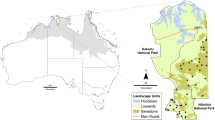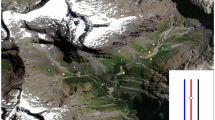Abstract
In an agroecosystem, catches of epigeal invertebrate predators obtained by pitfall traps were compared to absolute population densities estimated by ground photoeclectors in two different habitats, a field and an adjacent set-aside land. In general, abundance of Carabidae and Lycosidae were overestimated by pitfalls, while Staphylinidae and Linyphiidae were underestimated, and beetle larvae showed no obvious trend. The overestimation of Carabidae and Lycosidae by pitfalls had its maximum in spring and summer. Numbers collected by pitfalls did represent actual population densities better in the field than in the set-aside. This is probably caused by the higher vegetation diversity and complexity of the set-aside land which additionally influenced the catches. Pitfalls recovered higher numbers of animals and species, and species composition differed significantly between pitfalls and photoeclectors, in the field as well as in the set-aside. Body size seemed to be the main factor in determining the catch, the relatively larger species being more frequently caught by pitfall traps. In sum, the relationship between pitfall trap catches and actual population densities appeared to be either absent, weak or highly variable among taxa, habitat and time of the season. Thus numbers caught in pitfall traps cannot be considered as reliable indices of “real” abundance nor do they reflect the relative abundance within a given predator community correctly. Therefore, in most cases absolute density estimates should be preferred for the study of epigeal invertebrates in arable land. However, I suggest a combination of both pitfall traps and standardised area samples, because the two approaches possibly provide information of different qualities equally important for the evaluation of epigeal predator species, namely searching activity and population density.
Similar content being viewed by others
References
Adis, J., 1979: Problems of interpreting arthropod sampling with pitfall traps. Zool. Anz.202, 177–184.
Albrecht, H.;Anderlik-Wesinger, F.;Mayer, F.;Mattheis, A.;Kühn, N.;Toetz, P.;Pfadenhauer, J., 1996: Beitrag zur Minimierung der Belastung von Wässern und der Atmosphäre mit C- und N-Verbindungen. FAM-Bericht9 (ISSN 0941- 892X), 183–201.
Andersen, J., 1995: A comparison of pitfall trapping and quadrate sampling of Carabidae (Coleoptera) on river banks. Entomol. Fenn.6, 65–77.
Baars, M. A., 1979: Catches in pitfall traps in relation to mean densities of carabid beetles. Oecologia41, 25–46.
Basedow, Th.;Rzehak, H., 1988: Abundanz und Aktivitätsdichte epigäischer Raubarthropoden auf Ackerflächen - ein Vergleich. Zool Jb. Syst.115, 495–508.
Beese, R.;Hantschel, R.;Kainz, M.;Pfadenhauer, J., 1991: Forschungsverbund Agrarökosysteme München (FAM) - Er- fassung, Prognose und Bewertung nutzungsbedingter Verän- derungen in Agrarökosystemen und deren Umwelt. Verh. Ges. Ækol.20, 77–80.
Begon, M.;Harper, J. L.;Townsend, C. R., 1996: Ecology. Individuals, Populations and Communities. Blackwell, Oxford, 1-1068.
Desender, K.;Maelfait, J.-R., 1986: Pitfall trapping within enclosures: a method tor estimating the relationship between the abundances of coexisting carabid beetles (Coleoptera: Carabidae). Holarctic Ecol.9, 245–250.
Dinter, A., 1995: Estimation of epigeic spider population density using an intensive D-vac sampling technique and comparison with pitfall trap catches in winter wheat. In: TOFT, S; RlEDEL, W. (eds.): Arthropod natural enemies in arable land I. Acta Jutland.70, 23–32.
Ericson, D., 1979: The interpretation of pitfall catches ofPterostichus cupreus andPt. melanarius (Coleoptera, Carabidae) in cereal fields. Pedobiologia19, 320–328.
Franke, U.;Friebe, B.;Beck, L., 1988: Methodisches zur Ermittlung der Siedlungsdichte von Bodentieren aus Quadratproben und Barberfallen. Pedobiologia32, 253–264.
Freude, H.;Harde, K. W.;Lohse, G. A., 1976: Die Käfer Mitteleuropas. Band 2, Adephaga 1. Krefeld, Goecke und Evers, 1–302.
Greenestone, P. J. M., 1964: Pitfall trapping as a method for studying populations of Carabidae (Coleoptera). J. Anim. Ecol.33, 301–310.
Halsall, N. B.;Wratten, S. D., 1988: The efficiency of pitfall trapping for polyphagous predatory Carabidae. Ecol. Entomol.13, 293–299.
Hawthorne,A., 1995: Validation of the use of pitfall traps to the study of carabid population in cereal field headlands. In:Toft, S.;Rledel, W. (eds.): Arthropod natural enemies in arable land I. Acta Jutland.70, 61-76.
Heimer, S.;Nentwig, W., 1991: Spinnen Mitteleuropas. Berlin u. Hamburg, Paul Parey, 1–543.
Holland, J. M.;Thomas, S. R.;Hewitt, A., 1996: Some effects of polyphagous predators on an outbreak of cereal aphid (Sitobion avenae F.) and orange wheat blossom midge (Sitodiplosis mosellana Géhin). Agric. Ecosys. Environ. 59, 181–190.
Holland, J. M.;Thomas, S.R., 1997: Quantifying the impact of polyphagous invertebrate predators in controlling cereal aphids and in preventing wheat yield and quality reductions. Ann. Appl. Biol.131, 375–397.
HonÊk, A., 1988: The effect of crop density and microclimate on pitfall trap catches of Carabidae, Staphylinidae (Coleoptera), and Lycosidae (Araneae) in cereal fields. Pedobiologia32, 233–242.
Kromp, B.;Pflügl, Ch.;Hradetzky, R.;Idinger, J., 1995: Estimating beneficial arthropod densities using emergence traps, pitfall traps and the flooding method in organic fields (Vienna, Austria). In:Toft, S.;Rledel, W. (eds.): Arthropod natural enemies in arable land I. Acta Jutland.70, 87–100.
Lang, A., 1998: Invertebrate epigeal predators in arable land: population densities, biomass and predator-prey interactions in the field with special reference to ground beetles and wolf spiders. Ph. D. Thesis, Ludwig-Maximilians-Universitat München, 1–136.
Lang, A.;Fllser, J.;Henschel, J.R., 1999: Predation by ground beetles and wolf spiders on herbivorous insects in a maize crop. Agric. Ecosys. Environ.72, 189–199.
Luff, M. L., 1975: Some features influencing the efficiency of pitfall traps. Oecologia19, 345–357.
Luff, M. L., 1987: Biology of polyphagous ground beetles in agriculture. Agric. Zool. Rev.2, 237–278.
Lys, J.-A., 1995: Observation of epigeic predators and predation on artificial prey in cereal field. Ent. Exp. Appl.75, 265–272.
Mommertz, S.;Schauer, C.;Kösters, N.;Lang, A.;Filser, J., 1996: A comparison of D-Vac suction, fenced and unfenced pitfall trap sampling of epigeal arthropods in agro-ecosystems. Ann. Zool. Fennici33, 117–124.
Platen, R.;Blick, T.;Bliss, P.;Drogla, R.;Malten, A.;Martens, J.;Sacher, P.;Wunderlich, J., 1995: Verzeichnis der Spinnentiere (excl. Acarida) Deutschlands (Arachnida: Araneida, Opilionida, Pseudoscorpionida). Arach. Mitt., Sonderband1, 1–55.
Roberts, M.J., 1985: The Spiders of Great Britain and Ireland. Volume 1, Atypidae - Theridiosomatidae. Colchester, Harley Books, 1–382.
Scheinost, A., 1994: Pedotransfer-Funktionen zum Wasser- und Stoffhaushalt einer Bodenlandschaft. Ph. D. Thesis, Technische Universität München, 1–176.
Spence, J. R.;Nlemelä, J. K., 1994: Sampling carabid assemblages with pitfall traps: the madness and the method. Can. Entomol.126, 881–894.
Sunderland, K. D.;Topping, C. J., 1995: Estimating population densities of spiders in cereals. In:Toft, S.;Rledel, W. (eds.): Arthropod natural enemies in arable land I. Acta Jutland.70, 13–22.
Sunderland, K. D.;de Snoo, G. R.;Dinter, A.;Hance, T.;Helenius, S. J.;Jepson, P.;Kromp, B.;Lys, J.-A.;Samu, E.;Sotherton, N. W.;Toft, S.;Ulber, B., 1995: Density estimation for beneficial predators in agroecosystems. In:Toft, S.;Rledel, W. (eds.): Arthropod natural enemies in arable land I. Acta Jutland.70, 133–162.
Thiele, H. U., 1977: Carabid beetles in their environments. Berlin, Springer-Verlag, 1–369.
Toft, S.;Rledel, W., 1995: Arthropod Natural Enemies In Arable Land. Natural Science Series 9. Aarhus University Press, Aarhus. Acta Jutland.70, 13–161.
Topping, C. J., 1993: Behavioural responses of three linyphiid spiders to pitfall traps. Ent. Exp. Appl.68, 287–293.
Topping, C. J.;Sunderland, K. D., 1992: Limitations to the use of pitfall traps in ecological studies exemplified by a study of spiders in a field of winter wheat. J. Appl. Ecol.29, 485–489.
Trautner, J.;Geigenmuller, K.;Dlehl, B., 1984: Laufkäfer. Hamburg, DJN, 1–118.
Ulber, B.;Wolf-Schwerin, G., 1995: A comparison of pitfall trap catches and absolute density estimates of carabid beetles in oilseed rape fields. In:Toft, S.;Rledel, W. (eds.): Arthropod natural enemies in arable land I. Acta Jutland.70, 77–86.
Author information
Authors and Affiliations
Corresponding author
Rights and permissions
About this article
Cite this article
Lang, A. The pitfalls of pitfalls: a comparison of pitfall trap catches and absolute density estimates of epigeal invertebrate predators in Arable Land. J. Pest Science 73, 99–106 (2000). https://doi.org/10.1007/BF02956438
Issue Date:
DOI: https://doi.org/10.1007/BF02956438




